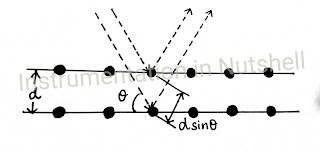Fibre Bragg Grating
 |
| Fibre Bragg Grating |
FBG’s are relatively simple to manufacture, small in dimension, low cost and exhibit good immunity from changing ambient conditions and EM radiation. FBGs can be used as an band stop optical filters in addition to its sensing applications.
Bragg’s Law
The name and theory of Fibre
Bragg Grating has its roots in Bragg’s law and applied to the periodic RI
modulations in the optical fibre core. Bragg’s Law was discovered in 1912
by Sir William Lawrence Bragg.
The law states that when an
electromagnetic radiation is incident onto a crystal surface, its
angle of incidence,θ, will reflect back with a same angle of scattering,θ.
And, when the path length of each wave, d is equal to an integer
multiple, n, of wavelength, a constructive interference will
occur.
The condition for constructive interference is nλ=2dsinθ
where,
λ is the wavelength of the x-ray,
d is the spacing of the crystal layers (path difference),
θ is the incident angle (the angle between incident ray and the scatter plane),
d is the spacing of the crystal layers (path difference),
θ is the incident angle (the angle between incident ray and the scatter plane),
and n is an integer
A diffraction pattern is obtained by measuring the intensity of the scattered
radiation as a function of the angle θ. Whenever the scattered waves satisfy
the Bragg condition it is observed a strong intensity in the diffraction
pattern, known as Bragg peak.
Inscription
of Gratings into Optical Fibre Core
The formation of permanent
gratings in an optical fibre was shown by Kenneth Hill and his team in 1978.
They launched an intense Argon-ion laser radiation at a wavelength of 488
nm into a germane silicate fibre and observed that the intensity of reflected
light is low, initially. After several minutes, an increase in the reflected
light intensity occurred which grew until almost all the light launched
into the fiber is back-reflected. The growth in back-reflected light is a
result of fibre photosensitivity.
The explanation is that at
the end of the fiber about 4% of the light was reflected by Fresnel reflection.
The reflected light interfered with the ongoing light producing an
interference pattern. This pattern contained peaks and valleys of a stationary
wave which imprinted permanently the pattern into the core of the fiber as an
index of refraction modulation. The change in refractive index is
permanent, provided the optical waveguide is annealed appropriately after the
imprint. (Annealing is a process heating for a few hours at a temperature of
50˚C above its maximum operating temperature.)
Theory
of Fibre Bragg Grating - Bragg Condition
 |
| Fibre Bragg Grating in Optical Fibre |
The Bragg Condition is the
compilation of two requirements:
1.Energy Conservation: Frequency of incident radiation and reflected
radiation is the same.
2.Momentum Conservation: Sum of incident wave vector and grating wave vector
is equal to the wave vector of the scattered radiation.
The resulting Bragg Condition is: λB = 2Λneff
where, λB is
the Bragg wavelength (λB)
Λ is the spacing between the
fiber gratings, called the grating period
and neff is
the effective refractive index of the core.
 |
| Input, Reflected and Transmitted Light Waveforms of Fibre Bragg Grating |
When a broad light beam is
send to FBG, reflections from each segment of alternating refractive index
interfere constructively only for a definite wavelength of light, known as
Bragg wavelength. This effectively causes the FBG
to reflect a specific frequency of light while transmitting all others.











No comments:
Post a Comment
Share your reading experience here